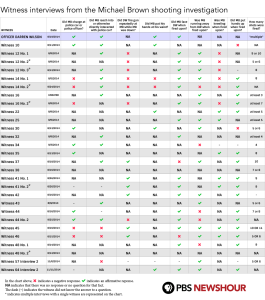What do the Newly Released Witness Statements Tell Us About the Michael Brown Shooting?
2014/11/26 – In the grand jury case against Ferguson police officer Darren Wilson, the prosecution revealed that physical evidence weighed in Wilson’s favor and that he had not unlawfully shot 18-year-old Michael Brown to death.
Over the course of the investigation, federal agents interviewed dozens of witnesses—some compelled to come forward by subpoena—to piece together what happened on that August 9 afternoon. Shortly after the press conference announcing the jury’s decision, St. Louis County Prosecuting Attorney Robert McCulloch released the transcripts of interviews with witnesses and Wilson.
We read and analyzed more than 500 pages of witness testimony and compared each statement to those given by Wilson. Below is a chart comparing several key details of the officer’s report to the witness statements. Was Brown facing Wilson when he was shot, or was his back turned to him? Did Brown have his hands in the air, or were they reaching toward his waist?
The chart above doesn’t reveal who was right or wrong about what happened that day, but it is a clear indication that perceptions and memories can vary dramatically.
Here’s a breakdown of the data we found:
- More than 50 percent of the witness statements said that Michael Brown held his hands up when Darren Wilson shot him. (16 out of 29 such statements)
- Only five witness statements said that Brown reached toward his waist during the confrontation leading up to Wilson shooting him to death.
- More than half of the witness statements said that Brown was running away from Wilson when the police officer opened fire on the 18-year-old, while fewer than one-fifth of such statements indicated that was not the case.
- There was an even split among witness statements that said whether or not Wilson fired upon Brown when the 18-year-old had already collapsed onto the ground.
- Only six witness statements said that Brown was kneeling when Wilson opened fire on him. More than half of the witness statements did not mention whether or not Brown was kneeling.
It is rare for authorities to release grand jury documentation, but the St. Louis County Office of the Prosecuting Attorney permitted the release of most of the documents on Monday, as The New York Times recently reported.
McCulloch highlighted the variations in witness accounts during the grand jury press conference. “In subsequent interviews with law enforcement, or their testimony before the grand jury, many of the same witnesses acknowledged that they didn’t actually see the shooting,” McCulloch said. “Some were running for cover. Some were relating what they heard from others or as I said, what they assumed happened.” But many witnesses held steadfast to their interviews. “Several other witnesses maintained their original statement that Mr. Brown had his hands int he air and was not moving toward the officer when he was shot,” McCulloch said.
Reading the witness interviews provides a revealing window into the grand jury’s investigation. What could a witness see while positioned a “few blocks” away from the incident, as in the case of Witness 30?
Witness 43, a juvenile who was listening to music at the time of the shooting, looked out the window and saw the incident. “I saw a man with his hands in a police car trying to snatch it away, and then he got away. [Officer Wilson] pulled out the taser and tried to tase him but he missed. Then he pulled out the gun and tried to shoot him and he missed. Then he ran down the street and then he shot him once and I stopped looking, but I heard like four or five more shots. Then when I looked back out there he was laying on the ground.”
With reporting by Ashira Morris, Adelyn Baxter, Ruth Tam and Travis Daub
Ed. Note: The table has been updated to more accurately reflect the witness testimony of Officer Darren Wilson, and language about witness testimony was clarified to say witness statements.




